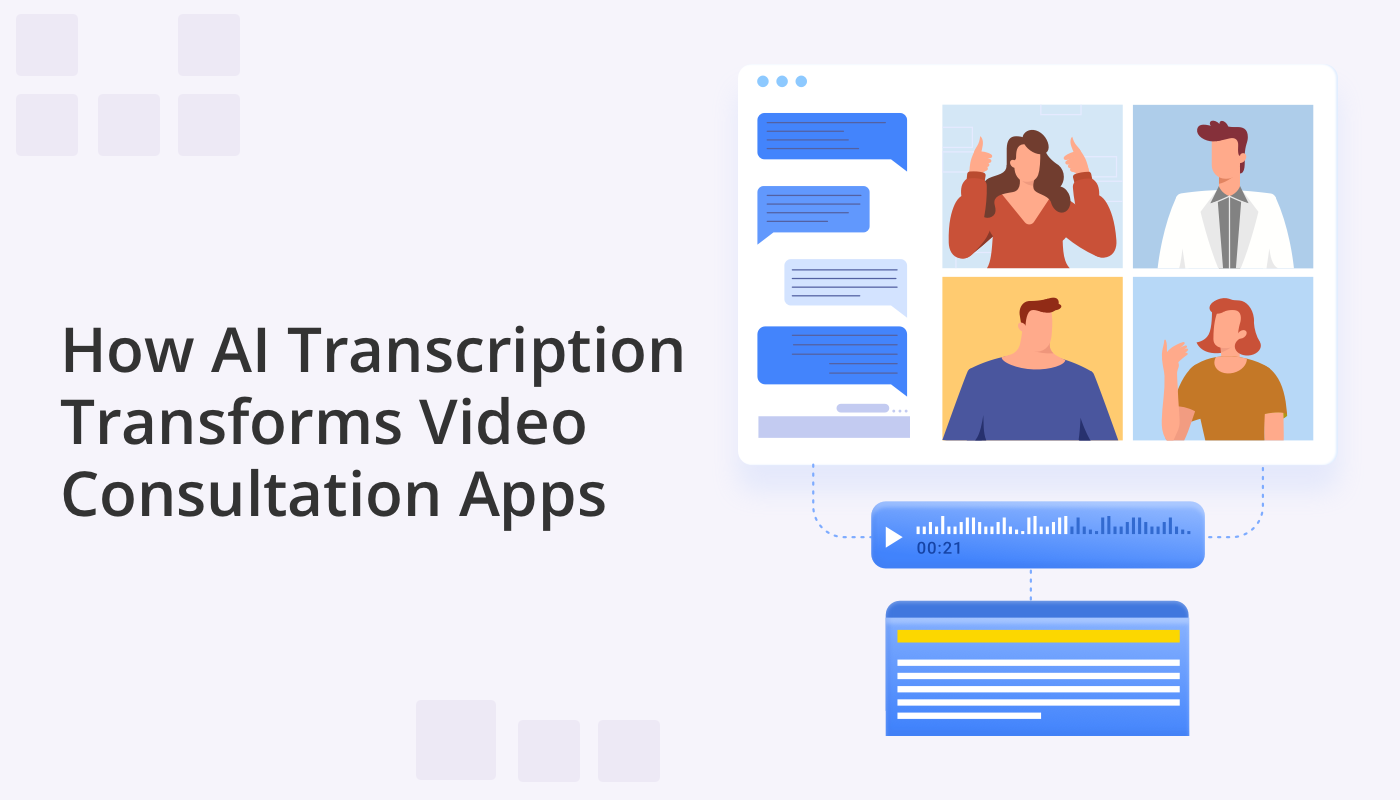
Whether it’s for remote work meetings, virtual social gatherings, or online learning sessions, video calling has become an integral part of our daily lives. However, as the demand for seamless video interactions continues to rise, so does the need for innovative solutions to enhance the overall experience. Enter the realm of AI transcription technology which is reshaping the way we communicate through video consultation apps, offering not only improved accessibility but also unlocking a new level of productivity and understanding in our virtual interactions. In the following blog we will explore the transformative impact of AI on video conferencing apps and discover how these advancements are ushering in a new era of connected and efficient communication.
Why your Video Consultation App needs Real-time Transcription
Real-time transcription during video calls offers a range of significant benefits that can enhance the overall communication experience for users.
Accessibility and Inclusivity:
One of the primary benefits is increased accessibility for individuals with hearing impairments. Real-time transcription provides a written representation of spoken words, allowing those who may have difficulty hearing to fully participate in conversations.
Improved Understanding:
Real-time transcription aids in comprehension by providing a visual representation of spoken words. This is particularly beneficial in situations where participants may have different native languages or accents, reducing misunderstandings and fostering clearer communication.
Enhanced Collaboration:
In collaborative settings, real-time transcription serves as a valuable tool for capturing key points, action items, and discussions. Participants can refer to the transcript during or after the call, ensuring that important details are not overlooked.
Efficient Note-Taking:
Participants no longer need to focus on taking detailed notes during a video call, as the real-time transcript provides an automatic record of the conversation. This allows individuals to stay engaged in the discussion without the distraction of manual note-taking.
Quick Reference and Review:
The availability of a real-time transcript enables quick reference and review of specific parts of the conversation. Users can easily navigate through the transcript to revisit important information or clarify details discussed earlier in the call.
Language Support:
Real-time transcription can be particularly valuable in multilingual environments. It helps bridge language barriers by providing a written representation of the conversation, making it easier for participants who may not be fluent in the spoken language.
Increased Focus on Communication:
Participants can focus more on the content and context of the conversation rather than struggling to catch every spoken word. This contributes to a more engaged and meaningful communication experience.
Remote Learning and Training:
In educational or training settings, real-time transcription facilitates remote learning by ensuring that participants have a clear and accurate record of the material covered. This is especially beneficial for virtual classrooms and online training sessions.
What is AI Transcription?
AI transcription refers to the use of artificial intelligence (AI) technologies to convert spoken language or audio content into written text. AI transcription systems leverage advanced machine learning algorithms, particularly those related to speech recognition and natural language processing, to automate the conversion of audio data into text.
Here’s a breakdown of the key components of AI transcription:
Speech Recognition: The core of AI transcription involves the use of speech recognition algorithms. These algorithms are trained on large datasets of diverse spoken language to accurately convert audio signals into written words. They can handle various accents, languages, and contextual nuances.
Natural Language Processing (NLP): NLP techniques are applied to understand the context and structure of the transcribed text. This involves parsing sentences, recognizing entities, and interpreting the meaning of words within the given context.
Language Models: AI transcription systems often use language models to improve accuracy. These models help predict the likelihood of a sequence of words, allowing the system to make more informed decisions about the most probable transcription in a given context.
Post-Processing: After the initial transcription, post-processing steps may be applied to refine the text. This could include grammar correction, contextual adjustments, and other enhancements to improve the overall quality of the transcribed content.
Adaptability: AI transcription systems can be trained or adapted to handle different domains, languages, and accents. Some systems are designed to specialize in certain industries, ensuring higher accuracy in specific contexts.
Learn more about: AI Enhanced Video Chat App: Introducing AI Answer Assist by QuickBlox
What’s so Special about AI-powered Transcription?
AI-powered transcription brings several distinctive advantages and capabilities compared to traditional transcription methods.
Automation and Speed:
One of the most significant advantages is the automation of the transcription process. AI-powered systems can transcribe large volumes of audio content in a fraction of the time it would take for a human to do the same task. This significantly improves efficiency, allowing for quick turnaround times.
Scalability:
AI-powered transcription can easily scale to handle varying workloads. Whether it’s transcribing a short interview or a lengthy lecture series, the system can adapt to the volume and complexity of the content without a proportional increase in time or resources.
Cost-Effectiveness:
Due to the automation and scalability, AI-powered transcription is often more cost-effective than traditional manual transcription services. This is especially beneficial for organizations or individuals with budget constraints who need to transcribe a large amount of audio content regularly.
Accuracy and Consistency:
Advanced machine learning models used in AI transcription systems are trained on vast datasets, making them adept at recognizing various accents, languages, and contextual nuances. This leads to high accuracy in transcriptions, and the consistency of results is maintained across different types of content.
Adaptability to Different Domains:
AI-powered transcription systems can be trained or adapted to specialize in specific domains. This allows for improved accuracy in industries with unique terminologies or jargon, such as legal, medical, or technical fields.
Real-time Transcription:
Some AI transcription systems offer real-time transcription capabilities, allowing users to receive written text as the spoken words are uttered. This is particularly valuable in scenarios like live broadcasts, meetings, or events where immediate access to transcribed content is essential.
Integration with Other Technologies:
AI-powered transcription can seamlessly integrate with other technologies, such as natural language processing (NLP) and summarization algorithms. This enables additional functionalities like sentiment analysis, content summarization, and categorization of transcribed data.
Learn more about: Enhancing Healthcare Apps with OpenAI Whisper and ChatGPT
Using AI Transcription in a Virtual Consultation App
Q-Consultation, by QuickBlox, is a remote consultation tool that seamlessly integrates video calling, virtual meeting rooms, and in-app chat, with advanced AI features, including transcription, summarization, and action point identification. The recent integration of AI functionalities, which has elevated the platform above conventional capabilities, promising users an enriched communication experience.
Enhanced Efficiency:
Businesses using Q-Consultation can now enjoy seamless transcription of their video calls. This feature ensures that every spoken word is accurately transcribed into text, providing a comprehensive and searchable record of discussions. This not only saves time on manual note-taking but also enhances the efficiency of post-call analysis and decision-making processes.
Summarization for Quick Insights:
The AI summarization feature adds a layer of intelligence to Q-Consultation, allowing businesses to distill lengthy discussions into concise summaries. This is particularly beneficial for busy professionals who need quick insights or for revisiting key points without having to review entire transcripts. It streamlines information consumption, making it easier for teams to stay informed and focused.
Actionable Takeaways with AI-Identified Action Points:
Q-Consultation goes beyond transcription and summarization by leveraging AI to identify and list action points from video calls. This feature ensures that crucial tasks and decisions are not lost in the details. Businesses can effortlessly convert discussions into actionable items, promoting accountability and streamlining the execution of decisions made during consultations.
Collaboration & Inclusivity:
The integration of AI-powered transcription enhances accessibility for all participants in a call. The written transcripts cater to individuals with hearing impairments, enabling them to fully engage in discussions. This inclusive approach aligns with modern business values, fostering diversity and ensuring that all team members can actively contribute to the conversation.
Data-Driven Decision-Making:
By combining transcription, summarization, and action point identification, businesses using Q-Consultation gain access to a wealth of data. This data can be analyzed for insights, trends, and patterns, facilitating data-driven decision-making. The app becomes not only a platform for communication but also a valuable tool for strategic planning and execution.
Learn more about: Announcing the Launch of Q-Consultation Lite! Free, Open Source Software
Learn more about: Product Update: Open Source Video Chat Integrated with AI
Final Words
The integration of OpenAI’s AI capabilities into the Q-Consultation app marks a significant leap forward in virtual collaboration. Businesses stand to benefit from enhanced efficiency, streamlined communication, and data-driven decision-making, ultimately paving the way for a more productive and insightful consultation experience. As organizations embrace the future of virtual collaboration, the marriage of AI and Video Consultation Apps proves to be a game-changer in shaping the way business is conducted in the digital era.
Talk to a sales expert
Learn more about our products and get your questions answered.
Contact sales






